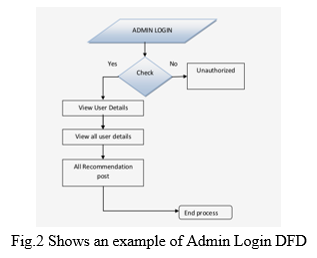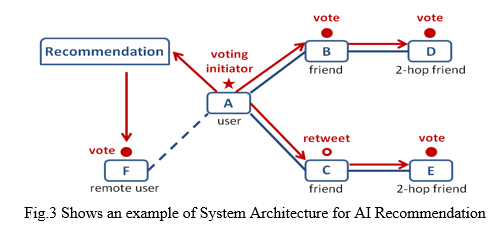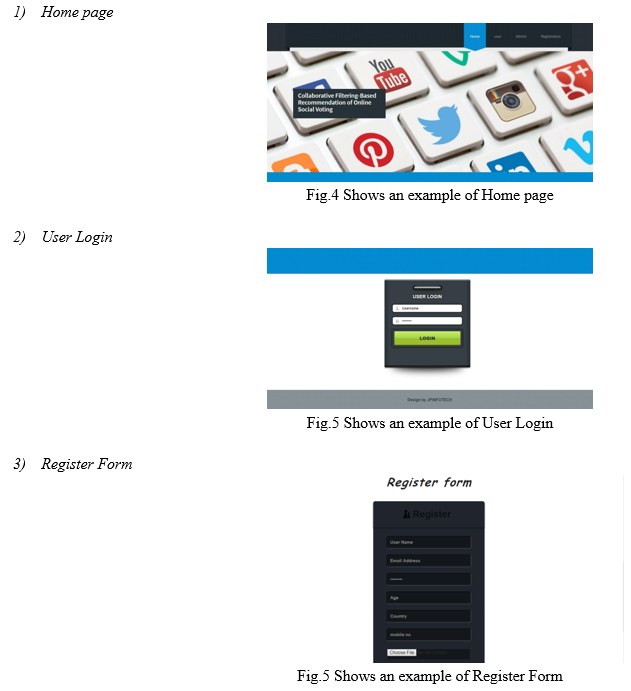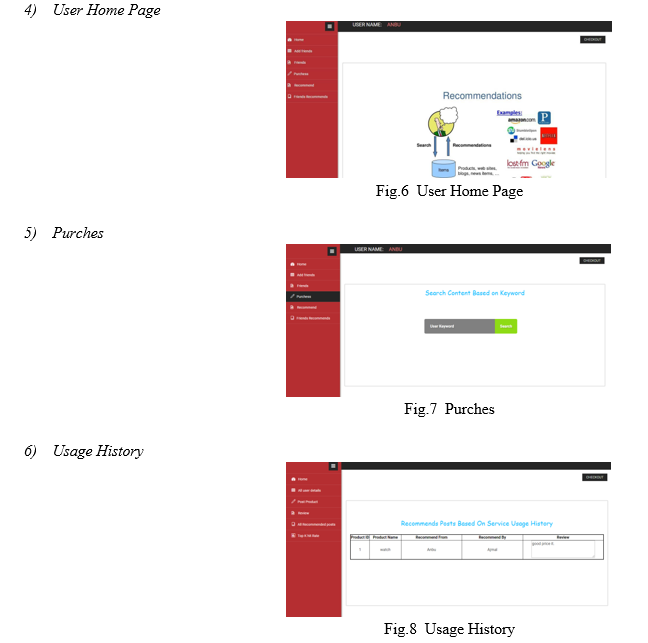Ijraset Journal For Research in Applied Science and Engineering Technology
- Home / Ijraset
- On This Page
- Abstract
- Introduction
- Conclusion
- References
- Copyright
Collaborative Filtering-Based Recommendation of Online Social Voting
Authors: Vandana Chobey, Ashwini Ghadge, Arati Landekar, Trishala Ther, Bhushan Raut, Payal Balbudhe
DOI Link: https://doi.org/10.22214/ijraset.2022.42817
Certificate: View Certificate
Abstract
Social vote casting is an rising new characteristic in on line social networks. It poses particular demanding situations and possibilities for advice. In this paper, we increase a fixed of matrix factorization (MF) and nearest-neighbor(NN)-primarily based totally recommendersystems (RSs) that discover consumer social community and institution association facts for social vote casting advice. Through experiments with actual social vote casting lines, we reveal that social community and institution association facts can appreciably enhance the accuracy of popularity-primarily based totally vote casting advice, and social community facts dominates institution association facts in NN- primarily based totally methods. We additionally take a look at that social and institution facts is a good deal greater precious to bloodless customers than to heavy customers. In our experiments, easy metapath primarily based totally NN fashions outperform computation-extensive MF fashions in warm-vote casting advice, even as customers’ pastimes for non-warm votings may be higher mined via way of means of MF fashions. We similarly endorse a hybrid RS, bagging one-of-a-kind unmarried methods to acquire the excellent top-ok hit rate.
Introduction
I. INTRODUCTION
In this Project we've got one-of-a-kind contents ar as follows.
A. What Is A Social Network?
Wikipedia defines a social community carrier as a carrier which “specializes in the constructing and verifying of on line social networks for groups of those who percentage pastimes and sports, or who're interested by exploring the pastimes and sports of others, and which necessitates using software.” A file posted via way of means of OCLC affords the subsequent definition of social networking webweb sites: “Websites basically designed to facilitate interplay among customers who percentage pastimes, attitudes and sports, consisting of Facebook, Mixi and MySpace.”
B. What Can Social Networks Be Used For?
Social networks can offer quite a number blessings to participants of an organisation:
- Support for Getting to Know: Social networks can decorate casual getting to know and guide social connections inside agencies of inexperienced persons and with the ones concerned withinside the guide of getting to know.
- Support for Participants of an Organisation: Social networks can probably be used my all participants of an organisation, and now no longer simply the ones concerned in running with students. Social networks can assist the improvement of groups of practice.
- Engaging with Others: Passive use of social networks can offer precious commercial enterprise intelligence and remarks on institutional offerings (despite the fact that this could provide upward thrust to moral concerns).
- Ease of get Admission to Facts and Programs: The ease of use of many social networking offerings can offer blessings to customers via way of means of simplifying get admission to to different gear and programs.The Facebook Platform affords an instance of the way a social networking carrier may be used as an surroundings for different gear. potential the interface and the manner the carrier works can be familiar, hence minimising education and guide had to make the most the offerings in a expert context
Examples of Social Networking Services Examples of famous social networking offerings include: - Facebook: Facebook is a social networking Web web website online that lets in humans to speak with their pals and trade facts. In May 2007 Facebook released the Facebook Platform which affords a framework for builders to create programs that engage with middle Facebook capabilities.
- MySpace: MySpace is a social networking Web web website online presenting an interactive, consumer-submitted community of pals, private profiles, blogs and agencies, normally used for sharing photos, tune and videos.
- Ning: An on line platform for developing social Web webweb sites and social networks aimed toward customers who need to create networks round particular pastimes or have restricted technical skills.
- Twitter: Twitter is an instance of a micro-running a blog carrier. Twitter may be utilized in quite a few methods which includes sharing short facts with customers and supplying guide for one’s peers.
II. AIM & OBJECTIVE
As we studied the content material facts on vicinity primarily based totally social networks with recognize to point-of-hobby properties, consumer pastimes, and sentiment indications, which fashions 3 styles of facts beneath Neath a unified point-of-hobby advice framework with the attention in their courting to check-in actions. In contrast, on line social voting’s are pretty one-of-a-kind from the conventional advice objects in phrases of social propagation. because it display via experiments with actual social vote casting lines that each social community facts and institution association facts may be mined to noticeably enhance the accuracy of popularity-primarily based totally vote casting advice. Aim to enhance advice accuracy for bloodless customers than for heavy customers. Social community facts and institution association facts can appreciably enhance the accuracy of popularity-primarily based totally vote casting advice, specially for bloodless customers, and social community facts dominates institution association information Aims to enhance visitors sectors via way of means of use clever tele cell smartphone application. Normal humans can do FIR in opposition to reputed person. User Or humans can do proceedings from anywhere, anytime.
III. RELATED WORK
One-magnificence collaborative filtering (OCCF) offers with binary score data, reflecting a consumer’s motion or now no longer. In OCCF, handiest high quality samples are observed, and there are a huge quantity of lacking entries.We display via experiments with actual social vote casting lines that each social community facts and institution association facts may be mined to noticeably enhance the accuracy of popularity-primarily based totally vote casting advice. Improved advice accuracy for bloodless customers than for heavy customers. Social community facts and institution association facts can appreciably enhance the accuracy of popularity-primarily based totally vote casting advice, specially for bloodless customers, an social community facts dominates institution association facts in NN-primarily based totally methods.
The feasibility of the venture is analyzed on this segment and commercial enterprise notion is placed forth with a completely trendy plan for the venture and a few value estimates. During gadget evaluation the feasibility look at of the proposed gadget is to be carried out. This is to make certain that the proposed gadget isn't a burden to the company. For feasibility evaluation, a few knowledge of the most important necessities for the gadget is essential.
IV. LITERATURE SURVEY
In first remark of “Toward the following era of recommender structures: A survey of the trendy and viable extensions” designed through G. Adomavicius and A. Tuzhilin, they gift a top level view of the sphere of recommender structures and describes the modern era of advice techniques which can be normally categorized into the subsequent 3 foremost categories: content-primarily based totally, collaborative, and hybrid advice tactics. This paper additionally describes diverse obstacles of modern advice techniques and discusses viable extensions which could enhance advice competencies and make recommender structures relevant to an excellent broader variety of applications. These extensions include, amongst others, an development of knowledge of customers and items, incorporation of the contextual data into the advice process, aid for multicriteria scores, and a provision of extra bendy and much less intrusive forms of hints. In second paper”Improving community topology-primarily based totally protein interactome mapping through collaborative filtering”, designed through X. Luo, Z. Ming, Z. You, S. Li, Y. Xia, and H. Leung, they constitute High-throughput screening (HTS) strategies permit big identity of protein-protein interactions (PPIs). Nonetheless, it's miles nevertheless intractable to have a look at the whole mapping of PPIs. With received PPI records, scalable and less expensive computation-primarily based totally tactics to protein interactome mapping (PIM), which goals at growing the records self assurance and predicting new PPIs, are preferred in such context. Network topology-primarily based totally tactics show to be distinctly green in addressing this issue; but their overall performance deteriorates appreciably on sparse HTS- PPI networks. Next study, “A easy however powerful technique to comprise depended on pals in recommender structures”, designed through G. Guo, J. Zhang, and D. Thalmann, it offers excessive nice hints is crucial for on-line structures to help customers who face a full-size range of selections in making powerful choice decisions.
Collaborative filtering is a broadly regular method to offer hints primarily based totally on scores of comparable customers. But it suffers from numerous troubles like records sparsity and bloodless start. To deal with those troubles, on this paper, we recommend a easy however powerful technique, namely "Merge", to comprise social believe data (i.e. depended on pals explicitly designated through customers) in presenting hints. More specifically, scores of a consumer's depended on pals are merged to symbolize the desire of the consumer and to locate comparable different customers for producing hints. Experimental effects primarily based totally on 3 actual records units show that our technique is extra powerful than different tactics, each in accuracy and insurance of hints.
V. DATA FLOW DIAGRAM

The DFD is likewise referred to as as bubble chart. It is a easy graphical formalism that may be used to symbolize a machine in phrases of enter information to the machine, diverse processing done in this information, and the output information is generated with the aid of using this machine. The information glide diagram (DFD) is one of the maximum essential modeling tools. It is used to version the machine additives. These additives are the machine process, the information utilized by the process, an outside entity that interacts with the machine and the data flows withinside the machine. DFD indicates how the data movements via the machine and the way it's miles changed with the aid of using a chain of variations. It is a graphical approach that depicts data glide and the variations which can be implemented as information movements from enter to output. DFD is likewise called bubble chart. A DFD can be used to symbolize a machine at any degree of abstraction. DFD can be partitioned into stages that constitute growing data glide and practical detail.

VI. SYSTEM ARCHITECTURE

In the bloodless-begin conditions wherein customers can also additionally have simplest rated some gadgets, the decomposition of consider matrix can assist to research greater dependable person-unique latent function vectors than scores-simplest matrix factorization. In the intense case wherein there aren't anyt any scores in any respect for a few customers, guarantees that the person-unique vector may be educated and found out from the consider matrix. In this regard, incorporating consider in a matrix factorization version can alleviate the bloodless begin trouble. By thinking about each specific and implicit affect of consider in place of both one, our version can higher make use of consider to similarly mitigate the information sparsity and bloodless begin issues.
VII. MODULES
- User: A person is someone who makes use of a laptop or community service. Users commonly use a machine or a software program product with out the technical information required to completely recognize it. Power customers use superior capabilities of programs, aleven though they're now no longer always able to laptop programming and machine administration.
Where customers also can percentage submit with others. The person can capable of seek the opposite person profiles and public posts. In this module customers also can take delivery of and ship buddy requests. With all of the fundamental function of Online Social Networking System modules is building up withinside the preliminary module, to show and compare our machine capabilities. In addition we increase this module with the aid of using that the customers can offer the Ratings. - Rating Prediction: In this module, we increase the choice of imparting the Rating with the aid of using the Social User. In this Rating Prediction a person can score the gadgets it indicates in big name primarily based totally version. The interactions of organization memberships decide if a person will hook up with some other person (i.e.,hyperlink prediction) or be interested by a goal object. However, the empirical consequences display that this version is higher at hyperlink prediction than score prediction. The maximum famous and broadly studied advice fashions are matrix factorization primarily based totally fashions which intention to factorize the person object score matrix into low-rank person- function and object function matrices. Although a person’s score to a sure object is especially decided with the aid of using the intrinsic attributes (or properties, capabilities) of the object in query and the way she appreciates those capabilities, a few extrinsic attributes might also have a non-negligible affect at the person’s scores. In this paintings, we attention at the affect of social consider in score prediction, i.e., the affect of consider associates on an energetic person’s score for a particular object, a.k.a. social affect.
- Friends Recommendation: In this module, we increase the Item Recommendation. Generally, in social score
networks a person can label (add) different customers as depended on buddies and as a consequence shape a social.
person u1 as trustworthy. Besides, customers can fee a fixed of gadgets the usage of some of score values, e.g., integers from 1 to 5. These gadgets will be products, movies, music, etc. of interest. The advice trouble on this paintings is to are expecting the score that a person will provide to an unknown object, for instance, the fee that person u3 will provide to object i3, primarily based totally on each a person-object score matrix and a person consider matrix. Other well-diagnosed advice troubles consist of for instance top-N object advice. - Al Recommendation Model: In this module first mathematically outline the advice trouble in social score networks, after which introduce the TrustSVD version.
VIII. SOFTWARE AND HARDWARE REQUIREMENTS
A. Software Requirements
- Operating System: Windows XP/7.
- Coding Language: JAVA/J2EE
- Data Base: MYSQL
B. Hardware Requirements
- System: Pentium IV 2.4 GHz.
- Hard Disk: 40 GB.
- Floppy Drive: 1.44 Mb.
- Monitor: 15 VGA Colour.
- Mouse: Logitech.
- Ram: 512 Mb.
IX. EXPERIMENTAL RESULT


Conclusion
In this Application, we gift a fixed of MF-primarily based totally and NN-primarily based totally RSs for on-line social vote casting. Through experiments with actual information, we discovered that each social community data and organization association data can substantially enhance the accuracy of popularity-primarily based totally vote casting advice, mainly for bloodless customers, and social community data dominates organization association data in NN-primarily based totally approaches. This paper proven that social and organization data is a good deal greater treasured to enhance advice accuracy for bloodless customers than for heavy customers. This is because of the reality that bloodless customers have a tendency to take part in famous votings. In our experiments, easy meta path-primarily based totally NN fashions outperform computation in depth MF fashions in warm-vote casting advice, whilst customers’ pastimes for non-warm votings may be higher mined with the aid of using MF fashions. This paper is simplest our first step towards thorough examine of social vote casting advice. As an instantaneous destiny paintings object, we would love to examine how vote casting content material data may be mined for advice, mainly for bloodless votings.
References
[1] R. M. Bond et al., A 61-million-person experiment in social influence and political mobilization, Nature, vol. 489, pp. 295–298, Sep. 2012. [2] G. Adomavicius and A. Tuzhilin, Toward the next generation of recommender systems: A survey of the state-of-the-art and possible extensions, IEEE Trans. Knowl. Data Eng., vol. 17, no. 6, pp. 734–749, Jun. 2005. [3] Y. Koren, Factorization meets the neighborhood: A multifaceted collaborative filtering model, in Proc. ACM KDD, 2008, pp. 426–434. [4] Y. Koren, Collaborative filtering with temporal dynamics, in Proc. KDD, Paris, France, 2009, pp. 447–456. [5] A. Paterek, Improving regularized singular value decomposition for collaborative filtering, in Proc. KDDCup, 2007, pp. 39–42. [6] R. Salakhutdinov and A. Mnih, Probabilistic matrix factorization, in Proc. NIPS, vol. 20. 2008, pp. 1257–1264. [7] K. Yu, A. Schwaighofer, V. Tresp, X. Xu, and H. P. Kriegel, Probabilistic memory-based collaborative filtering, IEEE Trans. Knowl. Data Eng., vol. 16, no. 1, pp. 56–69, Jan. 2004. [8] R. H. Keshavan, A. Montanari, and S. Oh, Matrix completion from noisy entries,J. Mach. Learn. Res., vol. 11, pp. 2057–2078, Jul. 2010. [9] P. Cremonesi, Y. Koren, and R. Turrin, Performance of recommender algorithms on top-N recommendation tasks, in Proc. ACM RecSys, 2010, pp. 39– 46. [10] Y. Zhang, B. Cao, and D.-Y. Yeung, Multi-domain collaborative filtering, in Proc. 26th Conf. Uncertainty Artif. Intell. (UAI), Catalina Island, CA, USA, 2010, pp. 725–732. [11] H. Steck, Training and testing of recommender systems on data missing not at random, in Proc. ACM KDD, 2010, pp. 713–722. [12] B. Marlin and R. Zemel, Collaborative prediction and ranking with non- random missing data, in Proc. ACM RecSys, 2009, pp. 5–12. [13] X. Yang, H. Steck, Y. Guo, and Y. Liu, On top-k recommendation using social networks, in Proc. ACM RecSys, 2012, pp. 67–74. [14] Y. Sun, J. Han, X. Yan, P. S. Yu, and T. Wu, PathSim: Meta path-based top- k similarity search in heterogeneous information networks, Proc. VLDB Endowment, vol. 4, no. 11, pp. 992–1003, 2011.
Copyright
Copyright © 2022 Vandana Chobey, Ashwini Ghadge, Arati Landekar, Trishala Ther, Bhushan Raut, Payal Balbudhe. This is an open access article distributed under the Creative Commons Attribution License, which permits unrestricted use, distribution, and reproduction in any medium, provided the original work is properly cited.

Download Paper
Paper Id : IJRASET42817
Publish Date : 2022-05-17
ISSN : 2321-9653
Publisher Name : IJRASET
DOI Link : Click Here
 Submit Paper Online
Submit Paper Online

